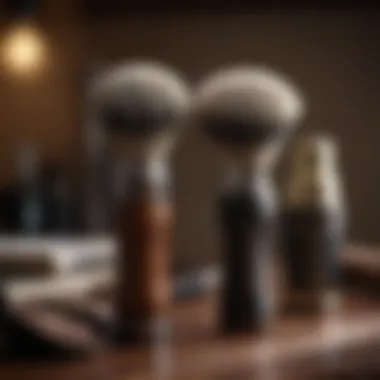Understanding Razor Burn: Causes and Solutions


Intro
Razor burn can be a frustrating and painful experience for many individuals. This skin irritation often occurs soon after shaving, presenting itself as discomfort and noticeable redness. Understanding the underlying causes is essential, as is finding effective solutions for prevention and relief. By examining factors such as changes in skin sensitivity, shaving techniques, and the condition of shaving tools, one can gain insight into this common issue.
This guide aims to provide a comprehensive overview of razor burn, diving into its causes and offering practical solutions. The goal is to equip readers with the knowledge needed to maintain healthy skin post-shave, allowing for a smoother grooming experience.
Causes of Razor Burn
Razor burn can stem from various sources, each contributing to the irritation experienced post-shave. Recognizing these causes can help individuals tailor their shaving practices effectively.
Skin Sensitivity
Skin sensitivity can fluctuate due to several variables, such as environmental changes, stress, and hormone levels. When skin becomes more sensitive, even a typical shave can lead to irritation. Individuals who notice increased red and bumpy patches might want to assess their skin's sensitivity prior to shaving. Keeping a skin journal can help track these changes over time.
Shaving Technique
The way one shaves plays a significant role in the likelihood of experiencing razor burn. Key techniques to consider include:
- Shaving against the grain: This method may seem more efficient but can irritate the skin. Instead, shaving with the grain is often gentler.
- Applying too much pressure: Excessive force while shaving increases friction, which can damage the skin's outer layer leading to razor burn.
- Overlapping strokes: Going over the same area repeatedly can exacerbate irritation.
Condition of Shaving Tools
The quality and condition of shaving tools affect every shave. Dull blades, for example, require more effort and lead to unnecessary skin trauma. It's essential to:
- Regularly replace blades to ensure they remain sharp.
- Clean razors thoroughly to prevent bacteria buildup.
- Use shaving cream or gel to provide a protective layer between the skin and blade.
Effective Management Strategies
While razor burn can be uncomfortable, several management strategies can reduce symptoms after a shave. These methods focus on soothing the skin and providing relief from irritation.
Post-Shave Care
Implementing proper post-shave care routines is crucial. The following can help soothe irritated skin:
- Cold compress: Applying a cold cloth to the affected area can reduce swelling and alleviate discomfort.
- Aloe vera gel: Known for its soothing properties, aloe vera can promote healing and calm irritation.
- Moisturizer: Using a gentle, fragrance-free moisturizer nourishes the skin and helps maintain its barrier.
Medications and Creams
In more severe cases of razor burn, over-the-counter products may provide relief. Look for:
- Hydrocortisone cream to lessen inflammation.
- Anti-inflammatory lotion to reduce redness.
Preventative Measures
Lastly, prevention plays a significant role in avoiding razor burn altogether. These tactics can significantly improve future shaving experiences:
- Choose the right razor: Invest in a high-quality razor designed for sensitive skin.
- Use good shaving cream: Select a cream that is hydrating and specifically formulated to prevent irritation.
- Examine shaving frequency: Depending on skin type, shaving every day may not be ideal; some may find every other day works better.
Closure
Understanding the causes of razor burn allows individuals to implement effective solutions and preventative strategies. By adjusting shaving techniques, maintaining shaving tools, and taking care of the skin post-shave, one can achieve smoother and healthier outcomes. This proactive approach ultimately leads to a more pleasant grooming experience.
Defining Razor Burn
Razor burn is a prevalent issue that affects many individuals who engage in regular shaving. It manifests as irritation, often leading to redness, discomfort, and sometimes a burning sensation on the skin. Understanding razor burn is crucial for anyone looking to maintain not only a clean appearance but also optimal skin health. A clear definition helps pinpoint specific causes and informs potential solutions, creating a roadmap for prevention and treatment.
Characteristics of Razor Burn
Razor burn is typically characterized by several distinct features. These include:
- Redness: The skin may become noticeably red in the areas where shaving occurred. This is often due to inflammation triggered by the shaving process.
- Bumps: Small, raised bumps can appear, giving the skin a rough texture.
- Itching: Many individuals report feeling an itchy sensation, which can exacerbate the urge to scratch or further irritate the area.
- Sensitivity: Areas affected by razor burn may become particularly sensitive to touch, producing discomfort during regular activities.
These characteristics offer a clear insight into how shaving can affect the skin, highlighting the delicate balance that exists between grooming and skin health.
Difference Between Razor Burn and Razor Bumps
It is essential to distinguish between razor burn and razor bumps, though many people use these terms interchangeably. The confusion often arises due to their similar presentations.
- Razor Burn is primarily a reaction of the skin's surface to the shaving process. The symptoms include irritation, redness, and sensitivity. This condition arises from improper shaving techniques, like using dull blades or insufficient lubrication. It usually resolves within a few hours to a couple of days, depending on treatment and care.
- Razor Bumps, on the other hand, are a condition known medically as pseudofolliculitis barbae. These occur when hair follicles become inflamed or ingrown. Razor bumps can lead to persistent irritation and may require more targeted treatments, such as topical medications. Unlike razor burn, these can last longer and require a more careful approach to prevent recurrence.
Recognizing this distinction is key in addressing the appropriate treatment method for each condition. When managing skin irritation post-shaving, understanding these differences can play an essential role in preserving skin health.
Common Symptoms of Razor Burn
Recognizing the common symptoms of razor burn is essential for anyone who regularly shaves. These symptoms serve as indicators of skin irritation and can guide individuals in addressing the issue promptly. Understanding these signs helps not only in soothing the skin but also in preventing future occurrences. By focusing on these symptoms, one can enhance their shaving experience, reduce discomfort, and maintain a well-groomed appearance without compromising skin health.


Redness and Inflammation
Redness and inflammation are usually the first signs of razor burn. After shaving, the skin may appear irritated with a noticeable reddish hue. This reaction occurs due to the damage caused by the razor blade, which can disrupt the outer layer of skin. Moreover, inflammation is the body’s natural response to injury, leading to swelling and heat in the affected area.
Key elements to note include:
- The severity of redness can vary, depending on skin type and the technique used during shaving.
- Targeting sensitive areas can exacerbate the issue, leading to more significant inflammation.
- Maintaining proper shaving techniques can help minimize irritation and redness.
"Recognizing redness early can allow for prompt care, possibly avoiding further irritation."
Itching and Discomfort
Itching is another common symptom linked to razor burn. Following a shave, the area may feel itchy and uncomfortable. This sensation can be particularly bothersome, often leading to scratching, which may worsen the situation. Discomfort can arise from several factors, including the sensitivity of the skin or products used during the shaving process.
Considerations to keep in mind include:
- Soothing products: Aftershave lotions or balms should be applied to calm irritated skin, reducing itching.
- Skin type: Individuals with sensitive skin often experience heightened discomfort, making it crucial to choose appropriate shaving products.
- Technique: Examining shaving methods may lead to discovering better practices that can minimize discomfort.
Understanding these symptoms is vital for formulating effective strategies to alleviate razor burn. Proper care and attention can help maintain skin integrity in the demanding realm of men's grooming.
Possible Reasons for Sudden Razor Burn
Understanding the potential reasons for sudden razor burn is crucial for anyone who wants to maintain a smooth and irritation-free shaving experience. This section will delve into specific elements such as changes in skin sensitivity, the impact of an inconsistent shaving routine, and the importance of maintaining your shaving tools. Moreover, the quality of the shaving products used and various environmental factors also play a significant role in razor burn. By comprehending these aspects, individuals can make informed choices to prevent discomfort and improve their shaving outcomes.
Changes in Skin Sensitivity
Skin sensitivity can fluctuate for various reasons. Factors such as hormonal shifts, weather changes, or even dietary choices can affect how your skin reacts to shaving. For instance, if you have recently started a new diet or are experiencing stress, your skin might become more prone to irritation. This heightened sensitivity may lead to razor burn. Being aware of these changes can help you adjust your shaving techniques and products accordingly.
Inconsistent Shaving Routine
An irregular shaving schedule can have adverse effects on your skin. Shaving too infrequently may lead to overgrown hair, which can create a rough surface for razors. Conversely, shaving too often without proper care may strip essential oils from the skin, causing irritation. Establishing a consistent routine, ideally every few days, helps the skin adapt and reduces the likelihood of razor burn. Consistency is key to keeping your skin in optimal condition.
Use of Dull or Damaged Blades
A dull razor blade is one of the most common culprits behind razor burn. It requires more pressure and multiple passes to achieve a clean shave, both of which increase the chances of irritation. Similarly, a damaged blade, with nicks or scratches, can catch and pull hair, further aggravating the skin. Regularly replacing blades and investing in quality razors can significantly decrease razor burn incidents.
Quality of Shaving Products
The products used during shaving play a vital role in skin health. Shaving creams and gels that contain harsh chemicals can irritate the skin and lead to razor burn. Look for products with natural ingredients that nourish the skin without causing a reaction. Furthermore, using a proper aftershave can soothe the skin and restore hydration. Selecting high-quality products tailored to your skin type can enhance your shaving experience.
Environmental Factors
External factors like humidity, temperature, and air quality also influence skin conditions. Dry or cold air can lead to dry skin, making it more vulnerable to irritation during shaving. Conversely, high humidity may allow for better lubrication but can also lead to clogged razors and less effective shaves. Monitoring your environment and adjusting your shaving techniques accordingly can prevent unnecessary discomfort.
"Understanding the underlying causes of razor burn is essential for developing effective preventive strategies."
By evaluating these elements critically, you can pinpoint potential causes of razor burn and adapt your grooming habits for better results.
The Role of Skin Care in Shaving
Skin care plays a fundamental role in the shaving process, emphasizing the need to prepare and care for the skin effectively. Razor burn often arises from insufficient skin care practices before and after shaving. Proper skin care can lead to a more pleasant shaving experience and significantly reduce the chances of irritation.
One essential aspect of skin care prior to shaving is preparing the skin. This involves moisturizing and cleansing before reaching for a razor. The benefits of a good pre-shave routine cannot be overstated. Not only does it soften the hair, making them easier to cut, but it also creates a protective barrier on the skin. This barrier can help prevent bacteria from entering open pores and can soothe skin irritation.
Pre-Shave Preparations
Pre-shave preparations include several steps that facilitate a smoother shaving experience. Here are key practices to consider:
- Cleansing: Wash your face with a gentle cleanser to remove dirt and oils. This helps to prepare the skin and ensures a clean surface for shaving.
- Exfoliation: If your skin tolerates it, exfoliating beforehand can assist in removing dead skin cells. This reduces the likelihood of ingrown hairs and allows for a closer shave.
- Moisturizing: Before applying shaving cream or gel, moisturizing the skin is vital. Look for products that are hydrating but not overly greasy.
- Pre-Shave Oil: Some people find pre-shave oils helpful. They provide an added layer of protection and can further soften hair.
Post-Shave Care
Post-shave care is equally important, as it can drastically minimize irritation and improve skin health. After shaving, the skin is often sensitive and exposed.
Consider the following steps as part of your routine:
- Rinse Cold: After shaving, rinse your face with cold water. This can help close the pores and reduce redness.
- Aftershave Products: Opt for alcohol-free aftershave products. These can soothe the skin and prevent dryness.
- Moisturization: Apply a good moisturizer ideal for your skin type. This helps to lock in moisture and supports skin healing.
- Avoid Harsh Ingredients: Steer clear of products with strong fragrances or irritants that could exacerbate any post-shave irritation.
Skin care is not an optional step in shaving; it is a necessity for maintaining skin health and minimizing razor burn.
In summary, dedicating time to skin care before and after shaving not only assures a better appearance but also enhances comfort. Paying attention to these aspects can lead to significant long-term benefits, making the shaving experience more enjoyable.
Shaving Techniques to Avoid Razor Burn
Razor burn can be a persistent source of discomfort for many men, often arising from improper shaving techniques. Understanding the specific elements that contribute to razor burn is essential in minimizing irritation. This section will outline key shaving techniques, their benefits, and considerations that can help maintain skin health while achieving a close and comfortable shave.


Angle and Pressure Control
The angle at which the razor blade meets the skin plays a significant role in preventing razor burn. Ideally, the blade should be held at a 30-degree angle relative to the skin. This angle allows the blade to cut the hair cleanly without tugging at the skin. Additionally, controlling the pressure applied during shaving is crucial. Excessive pressure can lead to nicks and irritation, increasing the likelihood of razor burn.
- Use light, short strokes with the razor.
- Allow the weight of the razor to do the work instead of pushing down harder.
Practicing this technique can make a noticeable difference in your post-shave comfort levels.
Shaving Direction
Shaving in the right direction is equally important in reducing irritation. Shaving against the grain, although it may seem like a good way to achieve a closer shave, can lead to significant irritation and razor burn. Instead, it is advisable to shave in the direction of hair growth. Doing so minimizes irritation and helps prevent ingrown hairs, a common result of against-the-grain shaving.
- Always assess the growth direction before starting.
- Shave with the grain initially, then if needed, make light passes against the grain for fine touch-ups.
Avoiding Multiple Passes
Making multiple passes over the same area can easily lead to irritation. Each pass increases the potential for skin damage, as the blade attacks the hair and the skin repeatedly. A thoughtful approach is to consider how to achieve a close shave without excessive passes.
- Try to achieve the desired closeness in as few passes as possible.
- If further passes are necessary, wet the skin and apply more shaving cream to soothe and moisturize the area before continuing.
By employing these shaving techniques, men can significantly reduce the occurrence of razor burn, leading to a more pleasant grooming experience. Incorporating proper angle and pressure control, shaving in the right direction, and avoiding excessive passes gives you a powerful arsenal against the irritation associated with shaving.
Remember, prevention is always better than treatment when it comes to skin irritation.
Choosing the Right Razor
Choosing the right razor is crucial for reducing the risk of razor burn. A well-suited razor type not only improves the shaving experience but also plays a significant role in skin health. Many factors contribute to determining the proper razor for individual needs. It's not just about preference; it’s about efficiency, comfort, and minimizing irritation.
When selecting a razor, consider your skin type, hair thickness, and shaving habits. For instance, sensitive skin may benefit from razors specifically designed to minimize friction and irritation. Choosing a razor that can adapt to your skin can lead to a smoother shave, reducing the chances of experiencing razor burn.
Safety Razors vs. Cartridge Razors
Safety razors and cartridge razors serve distinct purposes and offer various benefits. Safety razors have a single blade, which tends to provide a closer shave while minimizing skin contact. This characteristics can lead to less irritation for some users.
Cartridge razors, in contrast, are widely available and often come with multiple blades, designed to glide over the skin. While they can provide convenience, the multi-blade system may increase the potential for razor burn, particularly if used improperly. Therefore, personal preference, skin sensitivity, and shaving technique should guide the choice between these two options.
Tip: Always ensure the blade is sharp and clean, regardless of which type you choose, to reduce the risk of irritation.
Electric Razors Considerations
Electric razors offer a different shaving experience altogether. They are typically easier and quicker to use. However, the effectiveness of electric razors can vary. Some models are designed to be skin-sensitive, effectively minimizing the likelihood of razor burn.
When considering an electric razor, keep the following in mind:
- Skin Type: Electric razors may be less irritating for sensitive skin, as they often avoid direct blade contact.
- Hair Thickness: Thicker hair may require a more powerful electric razor to achieve a smooth shave.
- Cleaning and Maintenance: Proper care of electric razors is crucial for avoiding infections that could lead to razor burn.
- Features: Look for models with adjustable settings for a customized shaving experience.
Reviewing Shaving Products
In the context of razor burn, the selection of shaving products plays a pivotal role. Men's grooming is not merely a routine; it reflects personal style and hygiene. The type of products used for shaving greatly impacts skin health. Shaving creams, gels, and aftershave products can either soothe or irritate the skin. Thus, it is critical to scrutinize these items closely.
One must consider the ingredients in these products. Natural ingredients are often less irritating than synthetic ones. Additionally, products that offer hydration and lubrication can minimize the risk of razor burn. Familiarizing oneself with product labels helps in identifying formulas that are best suited for one’s skin type.
Furthermore, innovation in the industry has produced products that cater specifically to sensitive skin. These specialized formulas can provide a much-needed barrier during shaving, reducing the likelihood of irritation.
"The right shaving product can transform your routine from a source of irritation to a seamless experience."
Ultimately, investing time in reviewing shaving products is essential. Doing so not only enhances the shaving experience but also preserves skin integrity.
Shaving Creams and Gels
Shaving creams and gels are fundamental components of any shaving regimen. They serve a dual purpose: they moisturize the skin and create a lubricating layer over the hair. A quality cream or gel can make the razor glide smoothly, reducing friction and preventing small nicks or cuts.
When selecting these products, consider options that are alcohol-free and enriched with ingredients like aloe vera or vitamin E. These ingredients promote healing and offer anti-inflammatory benefits. A product with a rich lather can significantly improve comfort during shaving; this is vital for those prone to irritation.
There are also various formulations available, such as those designed specifically for sensitive skin. Such products often eschew harsh fragrances and focus on gentle, soothing properties.
- Look for:
- Hypoallergenic formulations
- Moisturizing ingredients
- Lack of irritating fragrances
In summary, selecting the right shaving cream or gel is a critical factor in preventing razor burn.
Aftershave Lotions and Balms
Aftershave lotions and balms are essential for post-shave care. They help to calm the skin, alleviate irritation, and close pores. These products are particularly important for individuals who experience razor burn frequently.


When choosing an aftershave product, it is wise to select one that contains soothing ingredients like witch hazel or chamomile. These can help mitigate redness and inflammation. Alcohol-based aftershave lotions tend to dry out the skin, so opting for balm formulations is often more beneficial for sensitive skin types.
The application of aftershave should be gentle. Rubbing can exacerbate irritation, whereas pressing the product onto the skin can be much more effective. This step is essential in healing and nurturing the skin post-shave.
Here are key features to look for in an aftershave:
- Soothing agents (like aloe or calendula)
- Moisturizers to prevent dryness
- Antiseptic properties to prevent infection
Aftershave products are not just an accessory; they are an integral part of post-shaving care that directly affects skin health.
Exploring Skin Conditions That Contribute to Razor Burn
Understanding the skin conditions that can lead to razor burn is essential for individuals who prioritize their grooming routine. Recognizing these issues can help you make informed choices about skincare and shaving practices. Certain skin conditions can exacerbate irritation during and after shaving. Addressing these underlying factors is critical for long-term skin health. In this section, we will explore two specific conditions that frequently contribute to razor burn: eczema and sensitive skin, as well as pseudofolliculitis barbae.
Eczema and Sensitive Skin
Eczema is a chronic skin condition that manifests as red, inflamed patches often accompanied by dryness and itching. Individuals with eczema may notice that shaving can aggravate their symptoms, leading to razor burn and increased discomfort.
Sensitive skin can include various types of skin, including those that easily react to external stimuli like products or changes in the environment. For these individuals, the act of shaving can cause heightened irritation. To minimize razor burn, it is important to take appropriate precautions such as:
- Using gentle, fragrance-free shaving products: Such products can reduce the risk of irritation.
- Opting for a less aggressive shaving technique: This involves using light pressure and avoiding multiple passes over the same area.
- Focusing on hydration: Keeping the skin moisturized can create a barrier that protects against irritation.
Maintaining an effective skincare routine that caters to sensitive skin can significantly alleviate the severity of razor burn, should it occur.
Pseudofolliculitis Barbae
Pseudofolliculitis barbae, commonly referred to as "razor bumps," is a condition characterized by inflamed bumps that develop after shaving. This happens when hair curls back into the skin after being cut. The outcome is uncomfortable and unsightly, resembling acne. This condition is particularly prevalent amongst individuals with curly hair.
Some steps that can be taken to alleviate symptoms include:
- Using proper shaving techniques: This can help prevent hair from curling back into the skin.
- Shaving against hair growth: This can sometimes help achieve a closer shave and minimize irritation.
- Incorporating exfoliation: Regularly exfoliating the skin can help remove dead skin cells and reduce the risk of ingrown hairs.
Proper understanding of skin conditions and adopting suitable shaving practices is crucial to minimizing razor burn.
Preventive Measures for Razor Burn
Razor burn can be a frustrating experience that affects not only the quality of a shave but also the overall appearance and comfort of your skin. Implementing preventive measures is crucial. The focus here is on developing habits that minimize irritation and enhance shaving safety. This section will examine key actions that individuals can adopt, highlighting their benefits and practical considerations.
Maintaining a Consistent Shaving Routine
A consistent shaving routine is essential in preventing razor burn. Regularity allows your skin to adapt to the shaving process. Here are some vital components:
- Frequency: Shaving too often can lead to irritation, while infrequent shaving can cause hair to grow out more, leading to more friction on subsequent shaves.
- Timing: Finding the right time to shave plays a role. For many, shaving after a warm shower helps soften the hair and opens up the pores, making the procedure smoother.
- Products: Using the same shaving cream or gel consistently can minimize reactions from newly introduced products, which may irritate sensitive skin.
Through maintaining a steady routine, your skin can adjust, which may contribute to reduced irritation and a smoother shave.
Regular Razor Maintenance and Replacement
Another critical aspect of preventing razor burn is keeping your shaving tools in optimal condition. Consider the following:
- Blade Replacement: Dull blades are a primary source of razor burn. Regularly replacing blades ensures a clean and efficient cut, reducing friction and skin irritation.
- Cleaning: Post-shave cleaning of your razor helps remove hair, cream, and bacteria. Neglecting this can lead to infections or additional irritation upon the next shave.
- Drying: Properly drying your razor after each use prolongs its life and minimizes the risk of rusting or damage.
Ensuring your razor is well-maintained supports a more effective and comfortable shave. You can achieve a more pleasant experience if you take these simple yet impactful steps into consideration.
Regular maintenance of your razor is as important as the products you use. A sharp, clean blade leads to a smoother shave and less irritation.
By adopting these preventive measures, you position yourself for success against razor burn. The continuity and care you invest in your shaving routine will be evident in the comfort of your skin.
When to Seek Professional Help
Recognizing when it is necessary to get professional medical advice for razor burn is an important aspect of skin care. While many individuals may experience minor irritation that can be managed at home, there are scenarios that warrant a visit to a healthcare provider. Ignoring severe symptoms can lead to further complications and prolonged discomfort.
Identifying Severe Reactions
Severe reactions from razor burn may manifest in several ways, including excessive redness, persistent swelling, or blistering of the skin. Additionally, if the area becomes painful or begins to ooze pus, these could indicate an infection or a more serious skin issue. Individuals should also note if these symptoms persist for more than a few days despite home treatment. It is crucial to monitor your skin’s reaction and seek help if you notice worsening conditions, as this could signify underlying problems that require professional intervention.
Consulting a Dermatologist
Visiting a dermatologist can provide valuable insights into managing and treating razor burn effectively. Dermatologists can offer tailored advice based on your specific skin type and shaving habits. They might suggest specialized treatments, recommend suitable skin care products, or even prescribe medication to alleviate symptoms. If you find that over-the-counter solutions have failed or if the razor burn occurs frequently, a consultation could help identify any underlying conditions such as sensitive skin or allergies that may be contributing to the issue.
Closure
In this article, we have explored the uncomfortable issue of razor burn, identifying the key causes, preventative strategies and effective solutions. Understanding razor burn is crucial for those who regularly shave, as skin irritation can significantly impact daily grooming habits and overall confidence. Men who are conscious of their style and appearance need to be proactive in their shaving practices.
The importance of a consistent and properly executed shaving routine cannot be overstated. Acknowledging factors such as blade quality, product selection, and shaving techniques directly contributes to minimizing the risk of irritation. Regularly updating tools and products ensures that one’s routine remains effective and safe.
Additionally, being aware of skin sensitivity and individual skin conditions like eczema or pseudofolliculitis barbae can help guide the approach to shaving. By choosing the right products and methods, men can promote healthier skin post-shave.
Here are key takeaways from our examination:
- Maintain proper hygiene and care for shaving instruments.
- Use suitable pre-shave and post-shave products to soothe and protect.
- Adapt shaving techniques according to personal skin characteristics.
Implementing these insights can lead to a more pleasant shaving experience, reducing discomfort and promoting a polished appearance. As razor burn is often preventable, educating oneself about potential hazards and solutions should be prioritized. Fortifying one’s grooming regimen can transform a routine task into a refined grooming practice.















